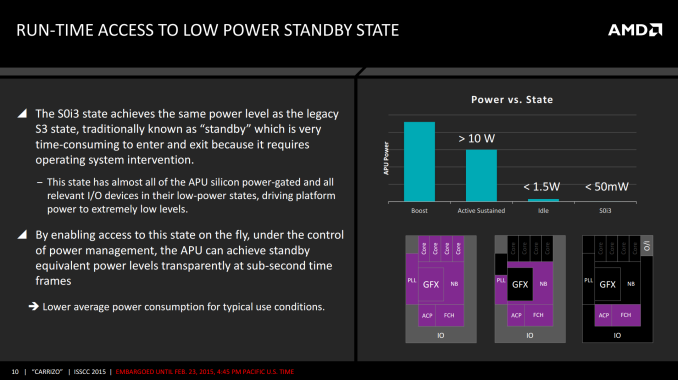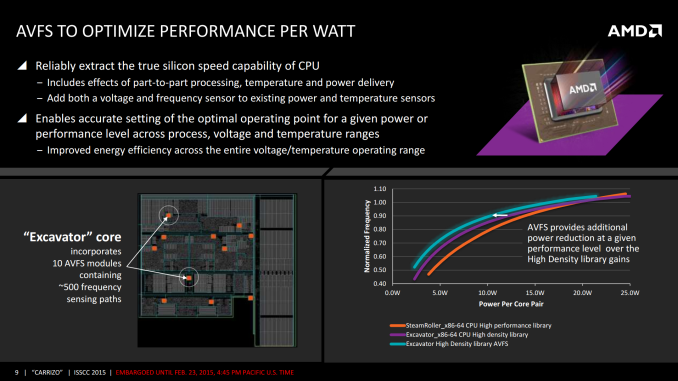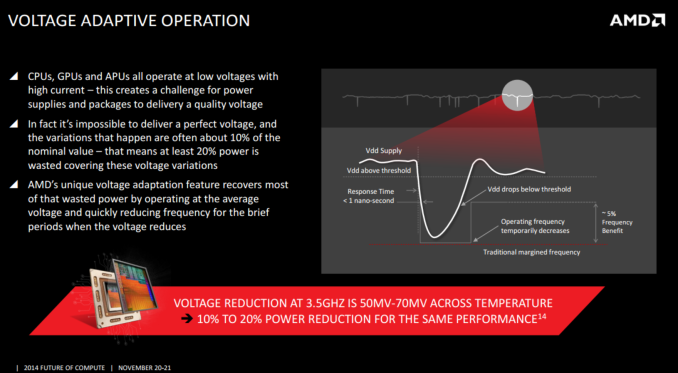AMD Launches Carrizo: The Laptop Leap of Efficiency and Architecture Updates
by Ian Cutress on June 2, 2015 9:00 PM ESTPower Saving and Power Consumption
When it comes to power, Carrizo features two/three technologies worth discussing. The first is the use of low power states, and the different frequency domains within the SoC. Previous designs had relatively few power planes, which left not as many chances for the SoC to power down areas not in use. Carrizo has ten power planes that can be controlled at run-time, allowing for what can be described as a dynamic race to sleep. This is bundled with access to the S0i3 power state, giving sub 50mW SoC power draw when in sleep and wake-up times under a second.
This is also combined with automated voltage/frequency sensors, of which an Excavator core has 10 each. These sensors take into consideration the instructions being processed, the temperature of the SoC, the quality of power delivery as well as the voltage and frequency at that point in order to relay information about how the system should adjust for the optimal power or performance point.
AMD states that this gives them the ability to adjust the frequency/power curve on a per-module basis further again to the right, providing another reduction in power or increase in frequency as required.
Next up for discussion is the voltage adaptive operation that was introduced back in Kaveri. I want to mention it here again because when it was first announced, I thought I understood it at a sufficient level in order to write about it. Well, having crossed another explanation of the feature by David Kanter, the reason for doing so clicked. I’m not going to steal his thunder, but I suggest you read his coverage to find out in more detail, but the concept is this:
When a processor does work, it draws power. The system has to be in a position to provide that power, and the system acts to restabilize the power while the processor is performing work. The work being done will cause the voltage across the processor to drop, to what we classically call Voltage Droop. As long as the droop does not cause the system to go below the minimum voltage required for operation, all is good. Voltage Droop works if the supply of power is consistent, although that cannot always be guaranteed – the CPU manufacturer does not have control over the quality of the motherboard, the power supply or the power conversion at hand. This causes a ripple in the quality of the power, and the CPU has to be able to cope with these ripples as these ripples, combined with a processor doing work, could cause the voltage to drop below the threshold.
The easiest way to cope is to put the voltage of the processor naturally higher, so it can withstand a bigger drop. This doesn’t work well in mobile, as more voltage results in a bigger power draw and a worse experience. There are other potential solutions which Kanter outlines in his piece.
AMD has tackled the problem is to get the processor to respond directly. When the voltage drops below a threshold value, the system will reduce the frequency and the voltage of the processor by around 5%, causing the work being done to slow down and not drain as much. At AMD’s Tech Day, they said this happens in as quickly as 3 cycles from detection, or in under a nanosecond. When the voltage drop is normalized (i.e. the power delivery is a more tolerable level), the frequency is cranked back up and work can continue at a normal rate.
Obviously the level of the threshold and the frequency drop will determine how much time is spent in this lower frequency state. We were told that with the settings used in Carrizo, the CPU hits this state less than 1% of the time, but it accounts for a sizeable chunk of overall average power reduction for a 3.5 GHz processor. This may sound odd, but it can make sense when you consider that the top 5% of the frequency is actually the most costly in terms of power than any other 5%. By removing that 5% extreme power draw, for a minimal performance loss (5% frequency loss for sub 1% of the time), it saves enough power to be worthwhile.













137 Comments
View All Comments
Cloakstar - Wednesday, June 3, 2015 - link
These scores definitely need validation. If true, Carrizo is a massive win.The FX 8800P graphic shows a 3DMark 11 score of nearly 2000 at 15W, and 2700+ at 35W.
The A10-7850k has a score of 2403 at 95W.
http://www.anandtech.com/show/7677/amd-kaveri-revi...
azazel1024 - Wednesday, June 3, 2015 - link
I didn't realize AMD's processors were so terrible at video playback. My 2 year old (pushing 3 now) Ivy Bridge i5-3317u equipped HP Envy 4t can manage roughly 6hrs of video playback of a 1080p h.264 12Mbps source and it only has about a 45whr battery in it. With a higher TDP chip and lots of "not power saving" features.creed3020 - Wednesday, June 3, 2015 - link
I am definitely in the market for one of these laptops to replace two older laptops in the house with one new one. If it had Carrizo for the hear I would be mighty happy to support AMD over Intel for this round, as the improvements here sound very much adequate for the system I am looking for.The ideal system would be something like the HP Spectre x360 for around $750.
michal1980 - Wednesday, June 3, 2015 - link
AMDs problem start with the 1st slide. "more people by notebooks priced between $400 and 700 than at any other price. Almost 2 out of every 5 notbooks sold is in that segment."umm, 3 out of 5 notebooks is sold outside of the 400-700 dollar price. Thats greater then 2 out of 5.
AMD fails math. Fails in general.
silverblue - Wednesday, June 3, 2015 - link
No. 3 out of 5 notebooks are either sold below $400, or above $700, and out of those two disparate segments, neither is as large as the $400 - $700 segment.There isn't a "math" fail here.
takeship - Wednesday, June 3, 2015 - link
The bigger issue is that AMD is admitting they are so uncompetitive in the market that it doesn't make business sense to chase at least 60% of consumers (and ignoring business costumers completely). And realistically, that 400-700 market is really more like a 550-700 market, as 400-500 is close enough to base iPad Air 2/premium Android tab pricing that you lose a lot of sales that direction.silverblue - Wednesday, June 3, 2015 - link
Surely TrustZone is a sign that they want business customers? Additionally, being able to work on the battery all day is a good thing.Gigaplex - Thursday, June 4, 2015 - link
Read closer. Their "all day battery" claim is being able to idle for 8 hours. You won't get a full work day out of that.silverblue - Friday, June 5, 2015 - link
If you class H264 1080p video as idle, sure. My fault for saying "work" though, however if all you're doing is light stuff, you won't be far off.FlushedBubblyJock - Wednesday, June 10, 2015 - link
for amd's sake we'll class idle as full screen video playback and 1.5 hours as all day, and no wifi bluetooth or dvd player active as full multimedia active -there, now look, you were correct ! your ego is in tact, you're never wrong
Calgon take me away